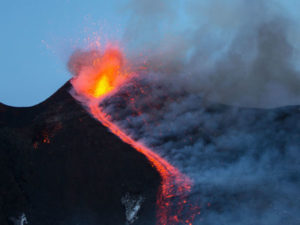

|
About 600 thousand years ago, following a collision between the Eurasian and Affrican plates, in the area of the pre- Etna golf (between the Iblean Plateau and the Peloritani mountains) an underwater liquid basaltic lava eruption occured, which over a long period of time led to the creation of Mount Etna’s edifice. Volcanic activity continued over hundreds and thousands of years, creating alkaline eruptive centres such as Calanna and Trifoglietto I, 200 thousand years ago. A new eruptive system was born 80 thousand years ago : ‘Unità del Trifoglietto’. It’s volcanic edifice, Trifoglietto II, was characterized by violent explosive acitivity, and collapsed 64 thousand years ago, thus creating the huge caldera known as Valle del Bove.
Activity ceased for about 50 thousand years, but then was re-awaken forming the eruptive centre of Mongibello Antico featuring two eruptive centres: Ellittico and Leone. Five thousand years ago, series of violent explosive eruptions led to the creation of the plateau, located at 3000 m a.s.l where are located the summit craters that mark the activity of Mongibello nowadays : Central Crater (1911), Northeastern Crater (1911), Bocca Nuova (1968), Southeastern Crater (1971). .
All these events contributed to the formation of Etna, also called Mongibello (from the Latin ‘mons’ and the Arab ‘gebel’ which both mean mountain) the highest active volcano in Europe (today it reaches a height of 3450 m a.s.l). |